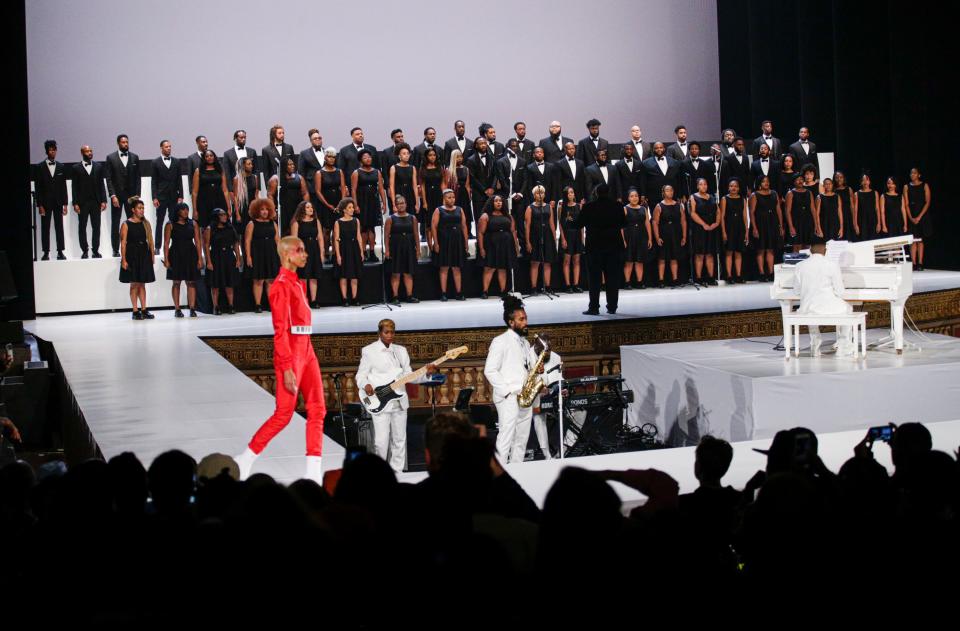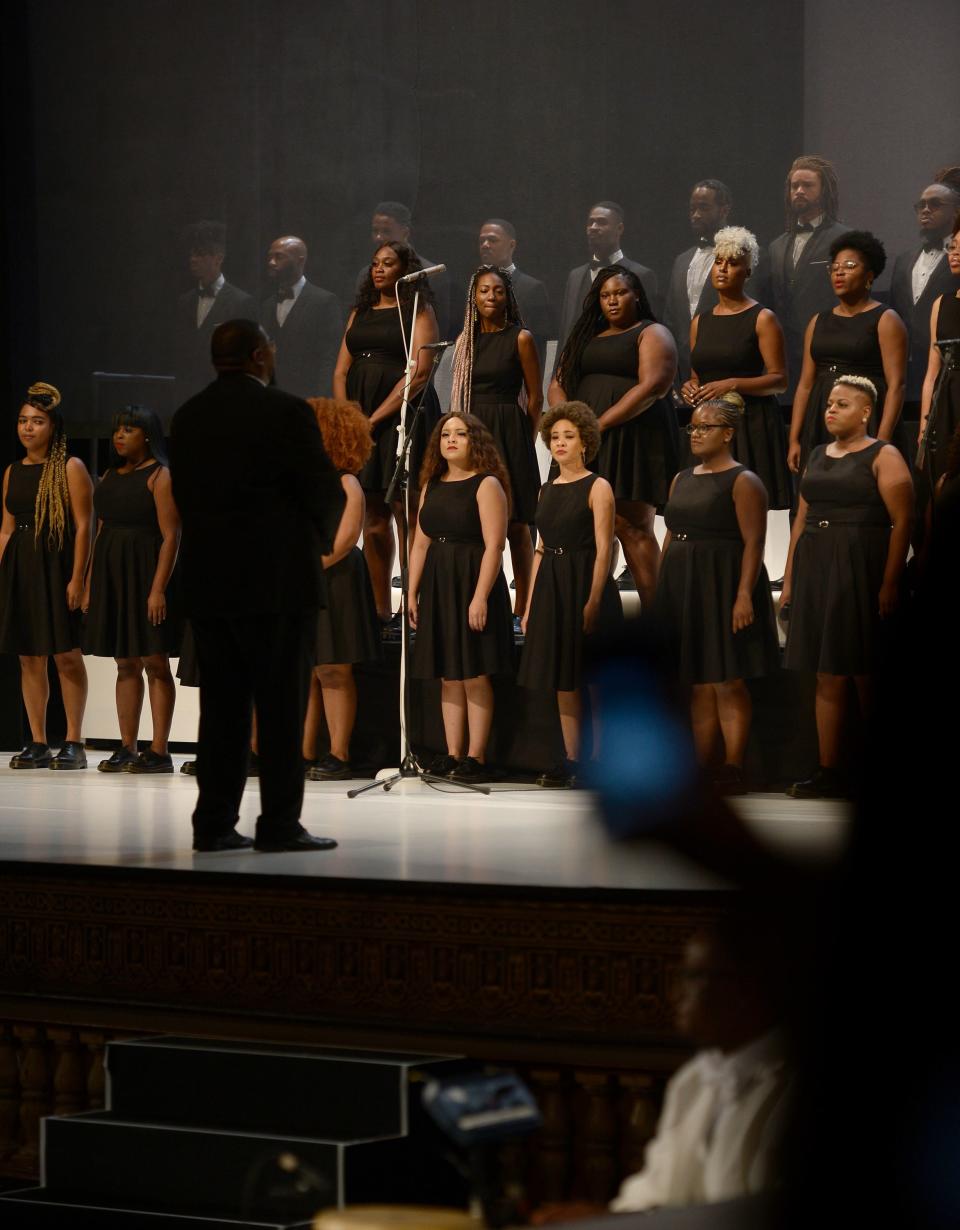Pyer Moss’s Kerby Jean-Raymond on the Making of His Biggest Choir Yet
Pyer Moss’s Kerby Jean-Raymond is sitting backstage at Flatbush’s newly renovated Kings Theatre, a former movie palace, which is the venue for the third installment of his “American, Also” collection. The faces of Erykah Badu, Lauryn Hill, and Missy Elliott—to name just a few of the artists that the designer had in mind with this new collection—are rendered as gold pendants on the table beside him in the so-called jewelry room; however, Jean-Raymond is much more focused on what’s going on on the other side of the backstage curtain. He intently watches a monitor that shows a live feed of the stage, as the 90 members of the Pyer Moss Tabernacle Drip Choir Drenched in the Blood file out to rehearse for the very last time before the massive production is unveiled to the 3,000 or so people who would fill the ornate theater later that night.

1166908223
Photo: Getty ImagesJean-Raymond formed the Tabernacle Drip Choir alongside his show director Dario Calmese in 2015—in the years since, including this season, producer Raphael Saadiq has served as the musical supervisor. It’s been a mainstay of Pyer Moss shows for the past few years, but last night was undeniably their biggest showing yet. The choir started with 16 members when it formed a few years ago, and it dwindled down to just eight members at one point, but now there’s an entire stage full of singers. They are currently practicing a medley that combines gospel songs like opener “How Shall I See You Through My Tears” from The Gospel at Colonus, a black musical adaptation of Sophocles’s tragedy Oedipus at Colonus, with Donny Hathaway’s “Little Ghetto Boy,” and even more contemporary songs like Cardi B’s “Money” and Missy Elliott’s “The Rain (Supa Dupa Fly).” There were moments in the performance, like with closer “Make Me Over,” where the strength of their amplified voices in unison literally made one’s hair stand on end.

1173279843
Photo: Getty ImagesThis iteration of the choir has particular significance this season given Jean-Raymond’s conceptual starting point: He aimed to rewrite the history of rock’n’roll to properly give due to Sister Rosetta Tharpe, a queer, black virtuoso guitarist and gospel singer from Arkansas who invented the sound that we now associate with rock music. “She toured the world and had a successful career, but we wrote her out of the history books and made it a patriarchal thing—a white thing—as opposed to really honor the woman who birthed rock’n’roll, which later birthed hip-hop and all these different things,” Jean-Raymond explains. “This season with the choir, we were focused on black women who I feel are part of the lineage of Sister Rosetta Tharpe, whether that be Lil’ Kim, Cardi B, Anita Baker, Patti LaBelle, or Whitney Houston. Black women have been so influential in American pop music and they dominate, and I hope that this medley empowers people… I want black women to see that we controlled this, and I want to see more black women in positions of power as it pertains to music,” Jean-Raymond continues.
Tharpe’s idiosyncratic mix of gospel, jazz, and blues proved controversial to some traditional gospel factions of her time, and Jean-Raymond takes a similar approach with his choir. “I told Dario in 2015 that I wanted to put together a trap opera, where we mix trap, opera, soul, R&B, and rap, all in a choir format, and we found 16 people. I loved them so much that the next season we used them again, and in everything that I do—it’s just getting bigger and bigger.” Calmese, the director, is a major force behind the choir’s continued growth. Calmese does extensive research before each medley is created—this season, he delved into rock’n’roll’s roots in rural southern quartet singing—but he’s not just focused on sound when compiling the composition with Jean-Raymond. “We make sure that the message of the song is right as well, and that it resonates with the brand ethos.” Starting off as a casting director at Pyer Moss, it wasn’t until Calmese played Jean-Raymond a video of him singing that he realized he had a deep theater history in ballet, opera, and more. Calmese’s father was a minister in his hometown of St. Louis, to boot, so he grew up singing in church. By the time he was 13, Calmese was directing 300-person choirs. “It’s kind of crazy now, looking back,” Calmese reflects over the phone the morning following the show.
Over the past year or so, the contemporary gospel archetype that Jean-Raymond pioneered has ushered in a whole wave of like-minded events—Grace Wales Bonner’s Devotional Sound turned a holy space into one ripe for meditation with performances from Solange and Laraaji, not to mention Kanye West’s hugely popular Sunday Service. “We came back this time with a little chip on our shoulder because in the year since our last show we’ve been seeing people who’ve done things that are close to our style and there’s a feeling of like, damn, this thing that we were doing for the love was taken from us,” Jean-Raymond says. “Yesterday at rehearsal, though, we were talking about why we do this, and all of these feelings of resentment dissipated. We do this to make people happy, just to literally put smiles on our own faces, and they do that to make people happy, so we’re all on the same side,” he adds. “If others have their own version of it, I’m not mad about it—as long as they’re keeping the integrity of the smiles.”
Originally Appeared on Vogue

